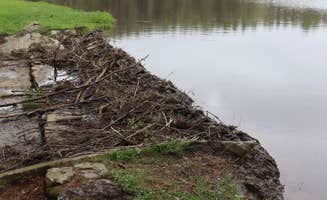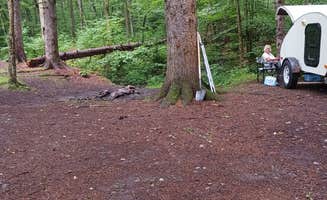Dispersed camping sites around North Java, New York are situated in the western portion of the state where the terrain features rolling hills and mixed hardwood forests. Most primitive camping near North Java is concentrated in state forest land between 1,600-2,100 feet elevation. Winter temperatures regularly drop below freezing, with significant snowfall possible from November through March, affecting accessibility to remote sites.
What to do
Fishing opportunities: At Palmers Pond State Forest, the pond supports various fish species despite water level fluctuations. One camper noted, "Lots of beavers to watch throughout the day," making wildlife observation a popular activity alongside fishing.
Hiking exploration: The woodland trails through Boyce State Forest connect to the regional Finger Lake Trail system. Trails vary in condition seasonally, with one hiker observing, "You'll spend more time beside the trail then actually on it," suggesting waterproof footwear is essential during wet periods.
Creek wading: The smaller waterways near Camp Seneca provide cooling relief during summer months. The campground features "several designated sites and most have a fire ring and picnic table" with access to a creek running alongside camping areas.
What campers like
Complete seclusion: Multiple reviews highlight the privacy at these primitive sites. At Camp Seneca, a camper reported, "We came into the area on a Monday and this camp was completely empty," showcasing the solitude available, especially on weekdays.
Natural canopy: The dense tree coverage provides natural shelter at most sites. One camper at Camp Seneca mentioned, "The tree canopy over our site was dense enough that we did not get very wet when it rains," offering protection from light precipitation.
Morning views: The combination of water features and forest creates memorable wake-up scenes. A visitor to Palmers Pond State Forest described, "Threw up the tentsile tent over looking the pond on the south side. What a wonderful way to wake up."
What you should know
Access road navigation: GPS directions frequently fail to provide correct routing to primitive camping areas. For Palmers Pond, a camper advises, "Beautiful grassy spots around the pond and along the road in. Google maps directed us to a dead end, go in through the north entrance and you'll be good!"
Site conditions vary by season: Late spring through early fall offers the most reliable camping conditions. At Ossian State Forest on Scoville Road, a visitor noted, "Only a couple of the primitive sites are accessible and most of the trails are choked with growth or blocked with fallen trees," indicating seasonal maintenance issues.
Basic sanitation facilities: Only some sites offer rudimentary toilet facilities. At Camp Seneca, campers found "a porti-poty on site that had plenty of paper was pretty clean," though most dispersed camping locations have no sanitation facilities.
Tips for camping with families
Choose sites with established amenities: For family camping near North Java, prioritize locations with basic infrastructure. One camper at Palmers Pond noted, "The site was very nice. Clean and well maintained. I was able to set up next to the water with no problem."
Consider accessibility needs: Some primitive sites require minimal hiking, while others need more effort to reach. At Boyce State Forest, "If you walk/hike 1/2 mile you will find a lean-to with fire pit and privy," which may be challenging for families with very young children.
Plan for wildlife encounters: Animals are common at these primitive sites, providing educational opportunities. Keep food secured and maintain appropriate distance from wildlife habitats, particularly beaver areas frequently spotted at Palmers Pond.
Tips from RVers
Road surface conditions: The access routes to primitive camping areas vary significantly in quality and maintenance. For Palmers Pond, a visitor shared, "The road was gravel but pretty easy to drive," suggesting smaller RVs can navigate in dry conditions.
Size restrictions: Most dispersed camping sites cannot accommodate large recreational vehicles. Stick to smaller camper vans and truck campers under 25 feet for most locations, as narrow forest roads limit access for larger rigs.
Self-contained requirements: No hookups or dumping facilities exist at primitive sites near North Java. All waste water must be properly contained and transported out, with campers bringing all necessary water supplies for the duration of their stay.



